Lion’s Mane Jellyfish: The World’s Largest Jellyfish Ever Recorded
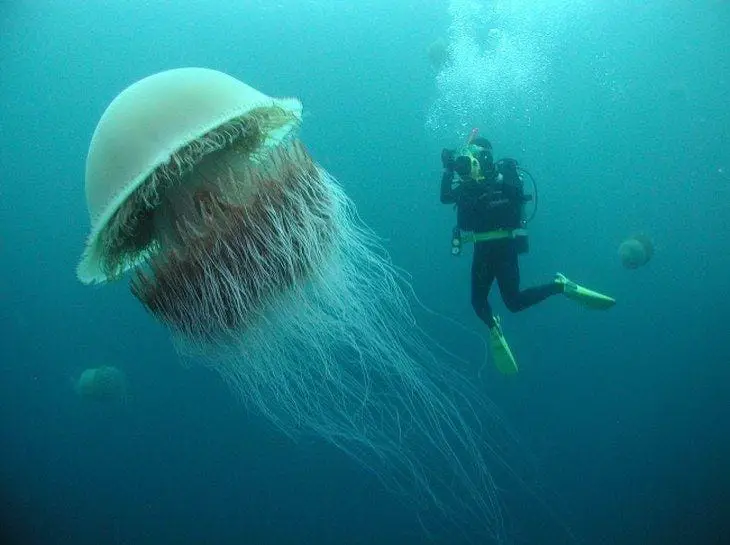
Have you ever considered coming face to face with a jellyfish that is larger than you? It would, without a doubt, be so horrible. As a lover of marine life, I am always fascinated by the amazing creatures that inhabit the ocean.
The Lion’s Mane Jellyfish, the world’s largest jellyfish ever recorded, is one such creature that always captures my interest. The Lion’s Mane Jellyfish is a sea marvel due to its striking appearance and massive size.
These magnificent creatures can reach lengths of up to 120 feet (36.5 meters) from top to bottom of their tentacles. Their bell can grow up to 7.5 feet in diameter, and their distinctive mane-like appearance gives them their name.
The Lion’s Mane Jellyfish is typically found in the Northern Hemisphere’s cooler waters, such as the Arctic, Atlantic, and Pacific oceans.
Despite their size and beauty, Lion’s Mane Jellyfish can be harmful to humans. Their tentacles are covered in tiny stinging cells known as nematocysts, which can sting painfully. It’s very important to avoid coming into contact with these creatures’ tentacles.
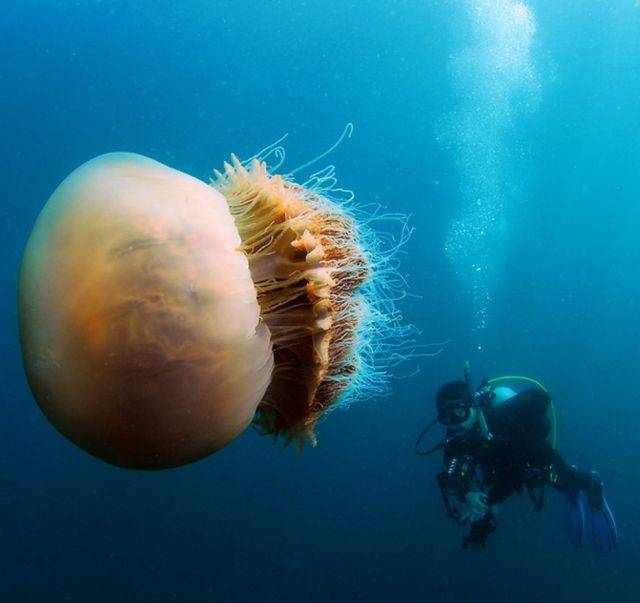
In 1865, Alexander Agassiz discovered this world’s largest jellyfish. It was discovered off the coast of Massachusetts and had a 7.5 -foot-diameter bell.
We will delve deeper into the fascinating world of the Lion’s Mane Jellyfish in this article. We’ll look at their anatomy, habitat, diet, and predators, as well as how they affect marine ecosystems.
We’ll also talk about the dangers and benefits of these creatures, as well as the conservation efforts underway to protect them. Join me on this journey to learn more about the world’s largest recorded jellyfish.
The Anatomy of the Lion’s Mane Jellyfish
Let’s take a closer look at the anatomy of the Lion’s Mane Jellyfish as we continue our exploration. These creatures have a fascinating and unique body structure that allows them to thrive in their marine environment.
The bell-shaped body of the Lion’s Mane Jellyfish is divided into eight distinct sections or lobes. The bell can grow to be up to 7.5 feet in diameter and is covered in a thick layer of mucus that protects the jellyfish from predators.
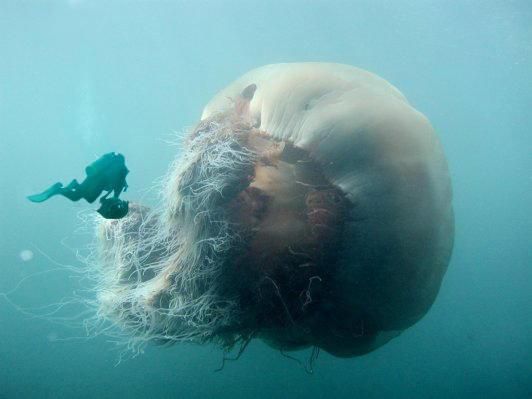
The bell is also filled with mesoglea, a watery substance that provides buoyancy and support. The top of the bell is often a dark yellow or red hue, and it is thicker in the middle than it is on the borders. However, it thins out as it moves out from the center.
The bell’s underside is lined with tentacles that can grow up to 120 feet long. The tentacles are covered in tiny stinging cells known as nematocysts, which are used to capture prey and protect against predators.
Because these stinging cells can cause a painful sting to humans, it is critical to avoid coming into contact with the tentacles.
The lion’s mane jellyfish is also capable of producing its own light and can shine in the dark when it is swimming under the deep ocean. This ability is known as bioluminescence.
The jellyfish’s mouth is in the center of the bell, surrounded by a ring of oral arms. These arms are responsible for capturing and transporting food to the mouth. The Lion’s Mane Jellyfish is a carnivorous jellyfish that eats plankton, small fish, and other jellyfish.
The Lion’s Mane Jellyfish has a simple nervous system that is distributed throughout its body via a nerve net. This enables it to detect its surroundings and respond to stimuli such as the presence of food or predators.
However, unlike more complex animals, it lacks a brain and a centralized nervous system.
In conclusion, the Lion’s Mane Jellyfish has a fascinating and unique anatomy that allows it to thrive in its marine environment. This creature is a marvel of the sea, from its bell-shaped body to its long tentacles and ring of oral arms.
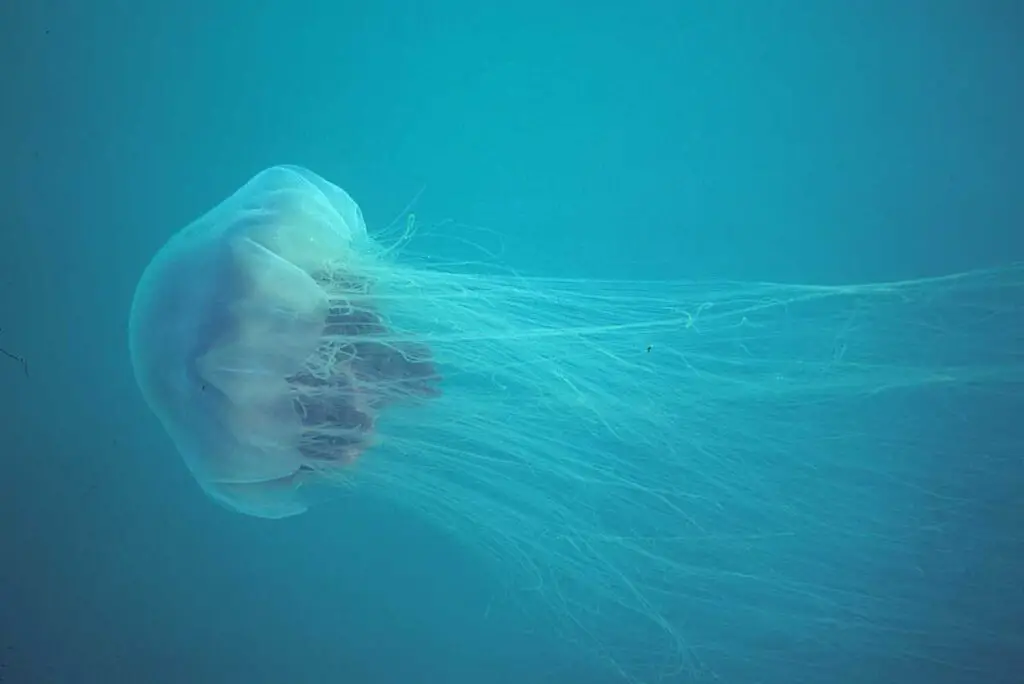
Habitat and Distribution of the Lion’s Mane Jellyfish
The Lion’s Mane Jellyfish is found in Northern Hemisphere waters, primarily the Arctic and North Atlantic Oceans.
These creatures prefer cooler waters and can be found up to 1,200 feet deep. They have been observed migrating to different areas based on water temperature and food availability.
During the summer, they can be found near the water’s surface, while during the winter, they migrate to deeper waters.
Lion’s Mane Jellyfish have also been observed to thrive in areas with strong currents, which aid in the transportation of both themselves and their prey. They are frequently seen near the coasts of Alaska, Canada, Japan, and the United Kingdom.
While the Lion’s Mane Jellyfish prefers cooler waters, they have been known to venture into warmer waters during periods of unusual ocean currents, such as the California coast.
This can be concerning because their presence in warmer waters can lead to an increase in their population and disrupt the local ecosystem.
Understanding their habitat and distribution is critical for conservation and management, especially because their presence in warmer waters can disrupt the local ecosystem.
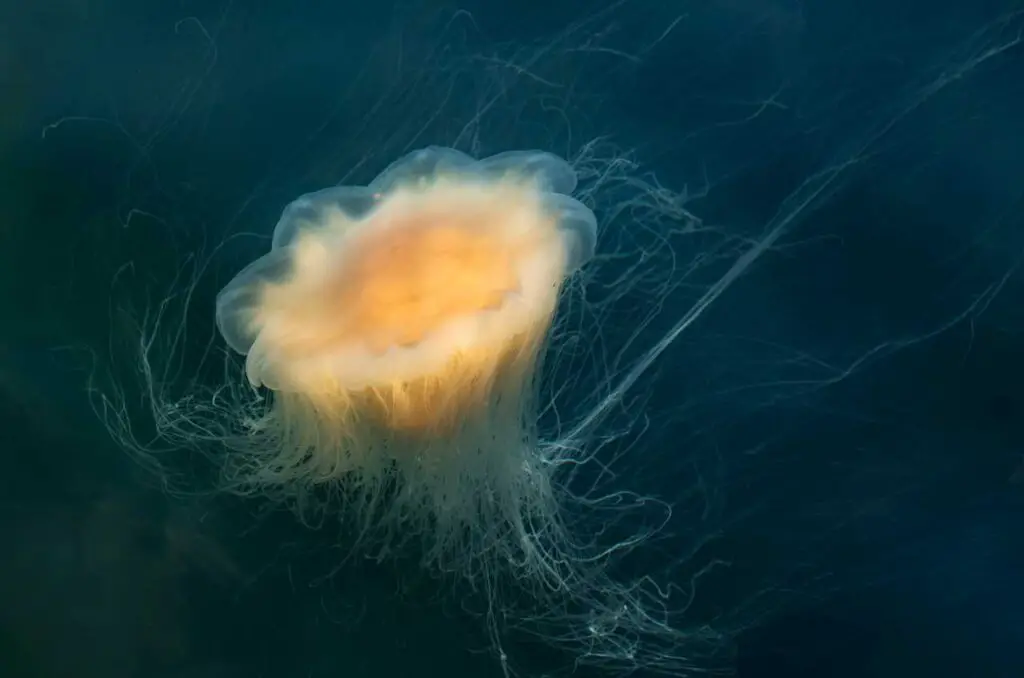
Lion’s Mane Jellyfish: Diet and Predators
The Lion’s Mane Jellyfish is a carnivorous predator that consumes a wide range of prey. Small fish, plankton, and other jellyfish make up the majority of their diet. They have a voracious appetite and can eat prey that is up to half their size.
Their tentacles, which can reach lengths of 120 feet, are lined with thousands of tiny, stinging cells known as nematocysts.
These cells secrete venom, which immobilizes their prey and allows the jellyfish to pull it into its mouth. Once the prey is within reach, the jellyfish moves it into its digestive cavity using its oral arms.
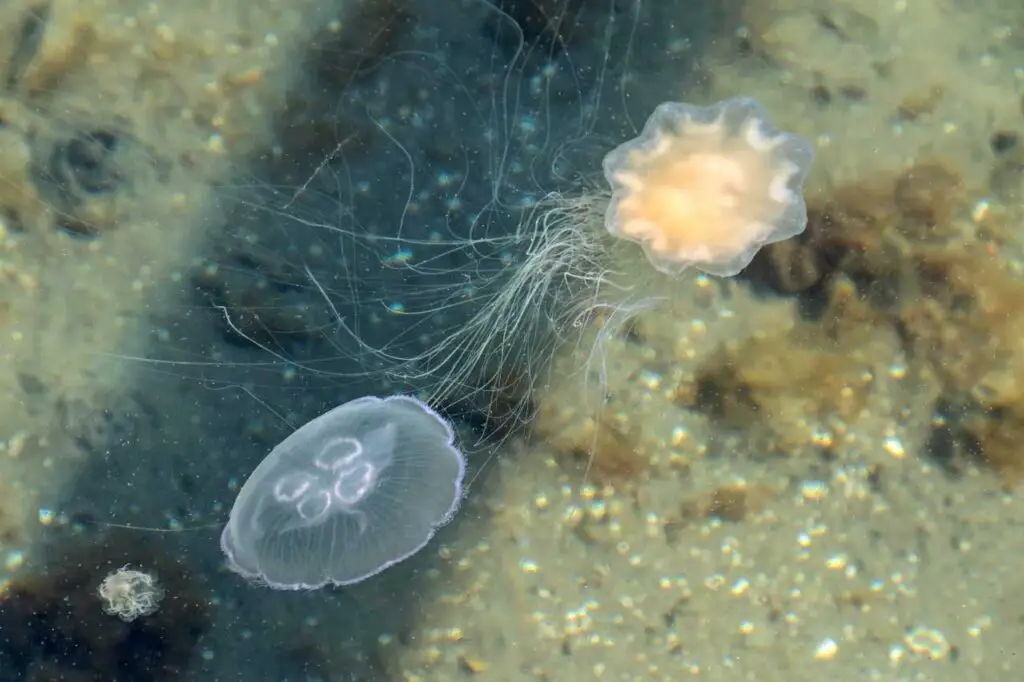
commons.wikimedia.org
The Lion’s Mane Jellyfish has several natural predators despite its size and venomous tentacles. Sea turtles, sunfish, and some bird species have been observed feeding on jellyfish, including the Lion’s Mane Jellyfish.
However, humans are the most significant predators of the Lion’s Mane Jellyfish, catching them for food or as tourist attractions.
While the Lion’s Mane Jellyfish may appear to be a nuisance due to their size and venomous tentacles, they play an important role in the marine ecosystem.
They help regulate the population of small fish and plankton as predators, which can prevent overpopulation and promote biodiversity. Furthermore, their presence in the ocean serves as an indicator of the marine environment’s health.
The Dangers and Benefits of the Lion’s Mane Jellyfish
The Lion’s Mane Jellyfish is an intriguing and one-of-a-kind sea creature. While they are fascinating to watch, they can also be dangerous to humans who come into contact with them. In this section, I’ll go over the benefits and the dangers of the Lion’s Mane Jellyfish.
Dangers:
The Lion’s Mane Jellyfish’s venomous tentacles are one of its most serious threats. The venom can cause a variety of symptoms, including skin irritation, respiratory distress, and, in severe cases, cardiac arrest.
While their stings are rarely fatal, they can be extremely painful and necessitate medical attention.
Another threat posed by the Lion’s Mane Jellyfish is its size. They are the world’s largest species of jellyfish, reaching lengths of up to 120 feet. A collision with one of these gigantic creatures can be hazardous, especially in the water.
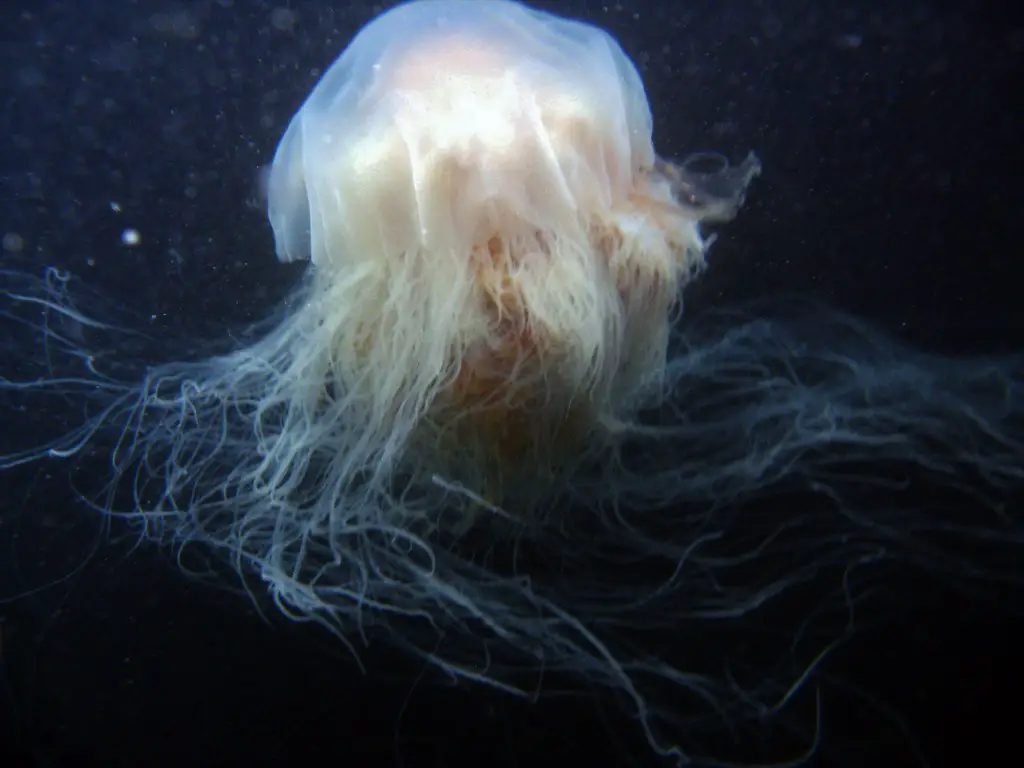
Benefits:
Despite its potential dangers, the Lion’s Mane Jellyfish has several advantages. One of the most significant advantages is their contribution to the marine ecosystem.
They help regulate the population of small fish and plankton as predators, which can prevent overpopulation and promote biodiversity.
Furthermore, the Lion’s Mane Jellyfish has been used for centuries in traditional Chinese medicine. The jellyfish is thought to have anti-inflammatory and antioxidant properties that can help treat a variety of ailments, including high blood pressure and arthritis.
likewise, the Lion’s Mane Jellyfish is a creature that should be treated with respect and caution. While their venomous tentacles and large size can be dangerous to humans, they also have several advantages.
As humans, we must work to balance the risks and benefits of the Lion’s Mane Jellyfish and protect it for future generations.
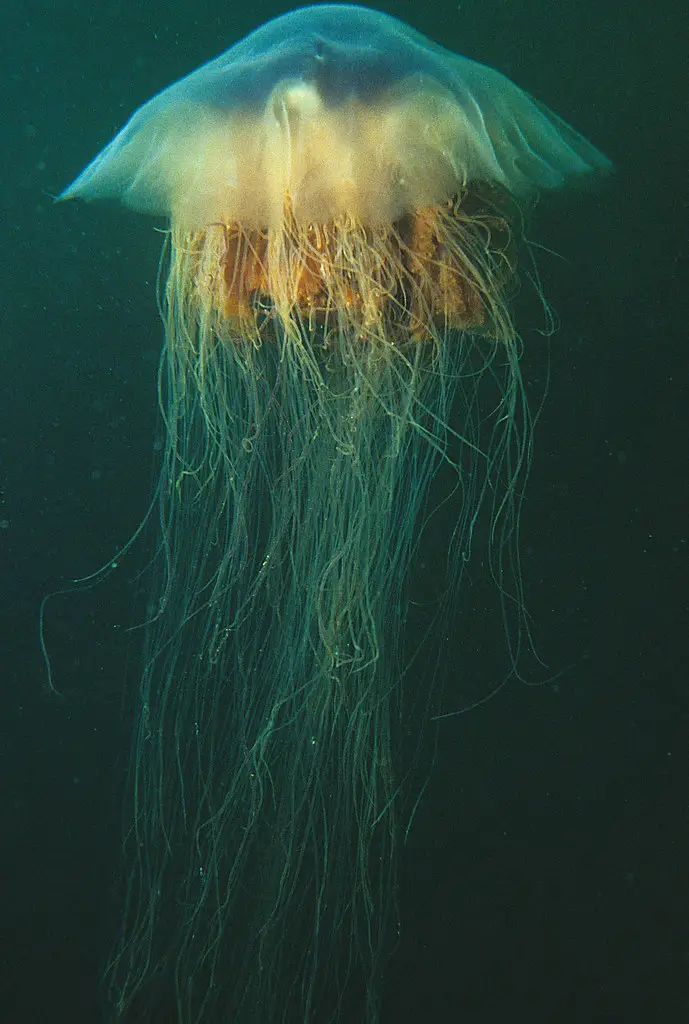
Conservation of the Lion’s Mane Jellyfish
The conservation of the Lion’s Mane Jellyfish is a critical issue that must be addressed. Despite being the largest jellyfish on the planet, it is still vulnerable to a variety of threats such as climate change, pollution, and overfishing.
Because climate change affects ocean temperatures, the Lion’s Mane Jellyfish has been found to spread further into the Northern Hemisphere.
This can be harmful to the ecosystem because it can disrupt the food chain. Furthermore, pollution, particularly plastic debris and oil spills, endangers the jellyfish’s habitat.
Another threat to the Lion’s Mane Jellyfish is overfishing, which can disrupt their natural predator-prey balance. For example, if a large number of sea turtles are caught, the jellyfish population will grow, potentially leading to harmful algal blooms. This can have a negative impact on the marine ecosystem.
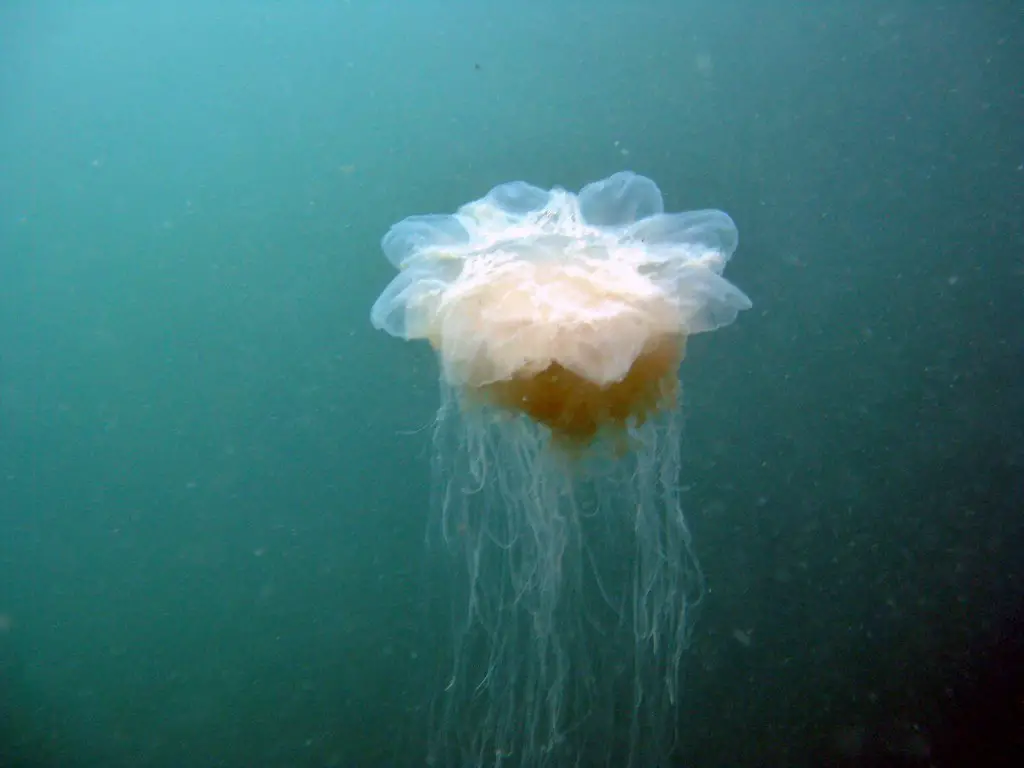
Reduce our use of single-use plastics and our carbon footprint to help conserve the Lion’s Mane Jellyfish. This can aid in the prevention of pollution and the slowing of climate change, both of which will benefit the ocean and its inhabitants.
Another option is to donate to organizations that work to protect marine life and the ocean ecosystem. We can help them protect and conserve the Lion’s Mane Jellyfish and other marine species by contributing financially or volunteering.
We can help ensure that this fascinating creature thrives for future generations by reducing our environmental impact and supporting conservation efforts.
Here are 10 Bizarre Sea Creatures Discovered Recently – You Won’t Believe Your Eyes!
FAQ!
Can jellyfish kill humans & What is the most poisonous jellyfish?
Box jellyfish are often regarded to be the most poisonous aquatic creature in the world with a box-like body structure. Box jellyfish have a dangerous toxin transmitted via their tentacles, which may be lethal.
Box jellyfish, such as the Australian box jellyfish, have been known to give people horrible, agonizing stings that may be deadly.

IMAGE: Guido Gautsch / CC BY-SA 2.0.
How can I protect myself from Lion’s Mane Jellyfish stings?
If you intend to swim or dive in an area known to be home to Lion’s Mane Jellyfish, it is best to wear a full wetsuit to reduce the risk of being stung. To relieve the sting, apply vinegar or baking soda to the affected area and seek medical attention right away.
Can Lion’s Mane Jellyfish be kept as pets?
Lion’s Mane Jellyfish should not be kept as pets because they require specialized care and can be dangerous if mishandled. Furthermore, due to conservation efforts, it is illegal in some areas to capture and keep them.
Can jellyfish survive out of water?
No, most jellyfish cannot survive for more than a few hours out of water. Jellyfish require water to sustain their soft bodies and move around. Some jellyfish, however, can survive for longer periods of time out of water if kept in a moist, cool environment.
How do jellyfish reproduce?
Jellyfish reproduce in both sexual and asexual methods. Male jellyfish release sperm into the water, which is then consumed by female jellyfish to fertilize their eggs. Jellyfish can reproduce asexually by cloning themselves or budding, which is when a small jellyfish grows from a part of an adult jellyfish.
Can jellyfish regenerate their tentacles?
Yes, many jellyfish species can regenerate tentacles that have been damaged or lost. This enables jellyfish to catch prey and defend themselves even if their tentacles are damaged during a fight or eaten by a predator.
